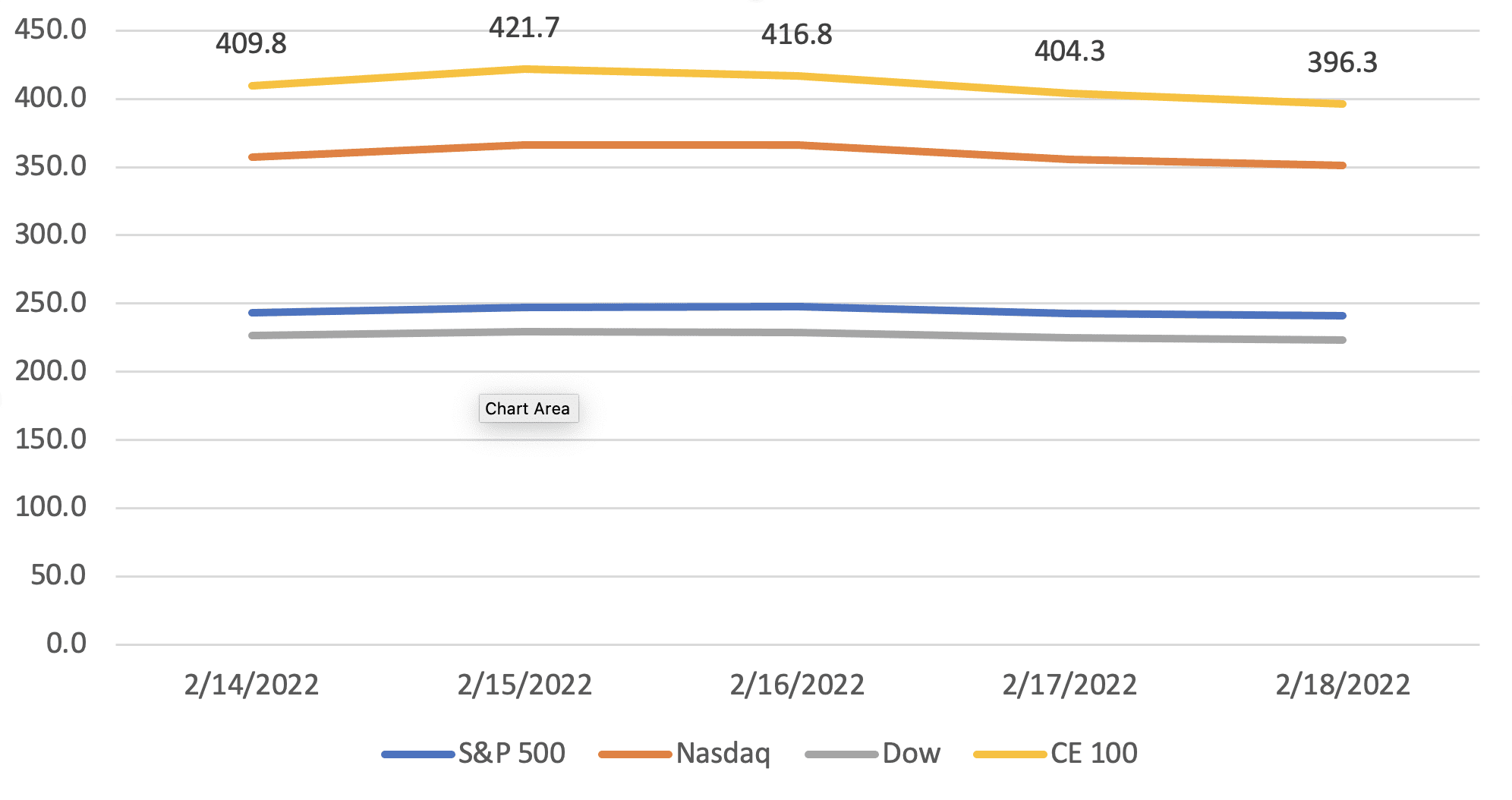
The CE100 slipped by 3.31% last week with players such as Fastly and Roblox losing more than a quarter of their stock value. In this week’s update, PYMNTS takes an assessment of the forces driving the shifts in the index and what’s to come.
Investors’ anxieties over escalating geopolitical tensions in Europe and fears surrounding federal interest rate hikes in the U.S. are creating turbulent market conditions, to say the least.
PYMNTS’ CE100TM Index, which tracks the performance of 100 publicly listed firms that are driving digital transformation in the global economy, saw its value decline by 3.31% over the course of last week despite a brief 2.90% climb Tuesday.
The Nasdaq Composite, meanwhile, retreated by 1.72%, followed by the Dow (-1.41%) and S&P 500 (-1.05%).
While the three major market indexes slumped last week as investors dumped risky assets and rotated into bonds in response to growing tensions between Russia and Ukraine, the decline in CE100 index reflected the shift in consumers’ behaviors as mask mandates and other existing COVID-era restrictions were dropped in several states across the U.S.
Figure 1: Market indexes’ performances during the week of Feb. 14

The Top and Bottom Performers of the Week
PYMNTS assessed the stock prices of all CE100 companies between Feb. 14 and Feb. 18, 2022, to identify the top and bottom performers of the week. Here’s what we found:
How The Connected Economy’s 10 Pillars Performed
The CE100 companies are distributed across 10 categories that PYMNTS has identified as the pillars of the connected economy. These pillars represent the activities in which people and businesses engage, as well as the enablers that offer the underlying software and infrastructure to facilitate this engagement.
PYMNTS’ analysis of the sub-Index value for each of these pillars shows that Live was one of the top-performing pillars last week although it experienced a slight decline last week.
The growth in the pillar was driven by Zillow, which is still benefiting from the boom in the U.S. housing market.
Move was the only pillar that experienced growth, improving by 1.2%. All other pillars saw declines in their Index values, though to varying degrees.
There are two key factors that explain the growth in the Move pillar. Firstly, we are continuing to see an increase in demand for faster and more efficient delivery solutions, which in result is creating new opportunities for players in the logistics industry. Secondly, workers in today’s connected economy are no longer tethered to their work desks and are instead choosing to travel to different destinations and work remotely. This shift has been a boon for players such as Airbnb.
“It’s now clear that we are undergoing the biggest change to travel since the advent of commercial flying,” Airbnb’s executive team noted in a letter to its shareholders.
In Q4, half of the stays that were booked on Airbnb’s platform were for a week or longer, while nearly 20% of the bookings were for 28 days or longer. Last week, the company saw its stock climb by 10.8%, making it one of the driving forces in the Move Pillar of the Connected Economy.
Figure 2: Performance of the connected economy’s 10 pillars during the week of Feb. 14
 While the Bank Pillar’s Index value slipped by 1% last week, it has outperformed all other pillars thus far, increasing by 44.5% from Jan. 1, 2021.
While the Bank Pillar’s Index value slipped by 1% last week, it has outperformed all other pillars thus far, increasing by 44.5% from Jan. 1, 2021.
On the other end of the spectrum is the Shop Pillar, which continued its losing streak. Its Index value declined by 5.4% last week and has dipped by 47.6% since January 2021.
Key players in the Shop Pillar, including Shopify, Pinduoduo and Mercado Libre, all saw their stocks tumble albeit for different reasons. Shopify, for one, beat expectations but is anticipating slower growth in the future as pandemic-era benefits are subsiding with the reopening of markets. Pinduoduo, meanwhile, is facing regulatory headwinds in China, where delivery platforms are being asked to reduce charges for restaurants so as to lower business costs.
The biggest loser last week was the Pay Pillar, which saw its Index value decline by 6.1%.
The decline came as a result of the poor performance of players such as PayPal, Sezzle, Square, Affirm and Tencent.
PayPal lost nearly two years’ worth of gains last week after the company backtracked on its goal of reaching 750 million active users by 2025 and slashed its outlook for new users by five million this year last week.
The company’s stock is down 47% year-to-date, and it saw a nearly 9% decline last week.
What’s to come?
Last Friday, U.S. officials confirmed that Russia plans to invade Ukraine in the next few days. The likelihood of an impending conflict is expected to create yet more uneasiness for the U.S. stock market in the coming weeks.
“Investors are having a hard time holding onto risk as the likelihood that the standoff between the West and Russia will ultimately lead to some ground conflict,” online trading firm OANDA’s analyst Edward Moya said on Friday. “Wall Street will remain jittery until we see a major de-escalation.”
PYMNTS will continue to track how the CE100TM and other major indexes’ performance. Stay tuned for more.